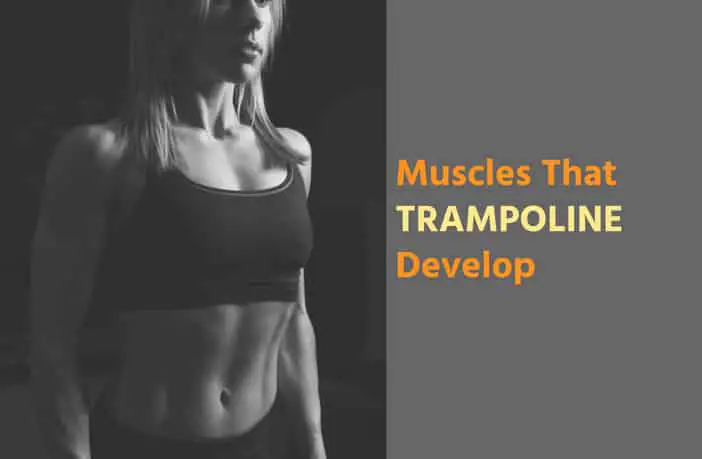Jumping on a trampoline is not only fun but a good fitness activity as well. With more and more people getting into trampoline workouts, it is important to know what muscles trampolining works.
While trampolining is on itself makes a good cardio workout, it can also tone certain parts of your body well. Sometimes even better than the conventional methods.
Learning the specifics can help you better mix it well with your other routine like resistance training, etc. Even if you’re not necessarily an athlete, consciously feeling how your particular muscles react to your bouncing will make the experience more enjoyable.
What Muscles Does Trampolining Work?
Shoulders & Back
As you bounce on your trampoline, the muscles on your shoulders and back contract. This is because they are all working together to help you keep your balance. It’s a sequence of contraction and relaxation but in a more natural way.
Compared to weight training and similar ones, jumping on a trampoline helps strengthen your back muscles and shoulder blades without putting too much strain on them. In fact, they don’t feel sore at all the next day.
This is also one of the secrets why trampolining is such a fun and relaxing activity. The tension that has accumulated on your shoulders and back are discarded away with each bounce.
Abdominals
Your abdominal muscles are also targeted every time you jump on a trampoline. In fact, this is a great alternative to conventional sit-ups.
Together with the shoulders and back, your abdominals help to strengthen your core. When you jump, no matter how high or low, your core muscles are actually used. Every time you land on a jumping mat, your abs flex naturally. It then relaxes every time you’re up in the air.
Your consistent jumping is what makes training your abs more effective.
Buttocks
Your lower body actually receives most of the conditioning. Trampolining, or rebounding, is a full-body workout in general, but the bulk of the conditioning is actually focused on the lower body.
This means your hips and buttocks get a lot of loving every time you bounce off the jumping mat.
To give you a more concrete example, sit slowly and bring your attention to your hips and buttocks. If you’re already seated, try to stand up and focus on how these parts of your body are engaged. This is exactly what’s happening when you jump on a trampoline but in a more intensive way.
Legs
Every time your legs come into contact with the jumping mat, your leg muscles are strengthened. Your knees and ankles get stronger.
In fact, you get to experience the benefits of running in a low-impact environment. Your knees do not have to receive the entire force of your weight plus the gravity. The jumping mat softens the impact for you.
As your entire legs get conditioned, blood circulation in this area improves. You get a big boost to your mobility, balance, and coordination.
Does Jumping On A Trampoline Build Muscle?
Jumping on a trampoline do build muscles. Specifically, it makes your muscles stronger and tones them. However, do not expect them to grow larger. Jumping on a trampoline does not build muscle mass.
Unless you have mass-building exercises included in your fitness routine, what you actually get is leaner, flexible, and stronger muscles.
Is Trampolining Good Exercise For Weight Loss?
Weight loss is all about burning calories and rebounding is one of the most fun ways of doing this. Studies show that when you jump on a trampoline for 10 minutes, you lose around 42 calories if you weigh about 150 lbs. Doing this for 30 minutes makes you burn up to 126 calories.
The great thing about this is you burn calories while having fun. There’s something about trampolining that helps you shed your worries away. Jumping on a trampoline helps prevent gaining more weight by eliminating stress.
If you want to make rebounding more effective, you can always alternate jumping jacks with your normal bouncing.
Does Jumping On A Trampoline Work Your Abs?
As you have learned earlier, abdominal muscles are naturally targeted by trampolining. You don’t necessarily need to do any complicated routine. Just bouncing is enough to shed those abdominal fats. However, you can make it more effective by toning your abs as well.
If you find doing crunches and something similar too boring or quite a challenge, then some modified jumping exercises below will do well for you.
Try air crunches by bringing your knees to your chest as you bounce up. You can also twist your body from side to side when you’re in the air.
These are a lot better than crunches which can place a lot of pressure on your back over time.
The best thing about this is you get to train your abs in a fun way. You get to work to shed those abdominal fats without even trying too hard.
Wrapping It Up
While jumping on a trampoline is considered a low-impact full-body workout, it also helps target and tone, specific muscle groups. Now that you know what muscles does trampolining work on, you’re sure to get more out of your trampolining routine aside from just having fun.

Exactly the information I was looking for. I always know there’s more to just having fun on a trampoline and your article nailed it for me.